light SKODA SUPERB 2010 2.G / (B6/3T) Repair Manual
[x] Cancel search | Manufacturer: SKODA, Model Year: 2010, Model line: SUPERB, Model: SKODA SUPERB 2010 2.G / (B6/3T)Pages: 287, PDF Size: 16.59 MB
Page 86 of 287
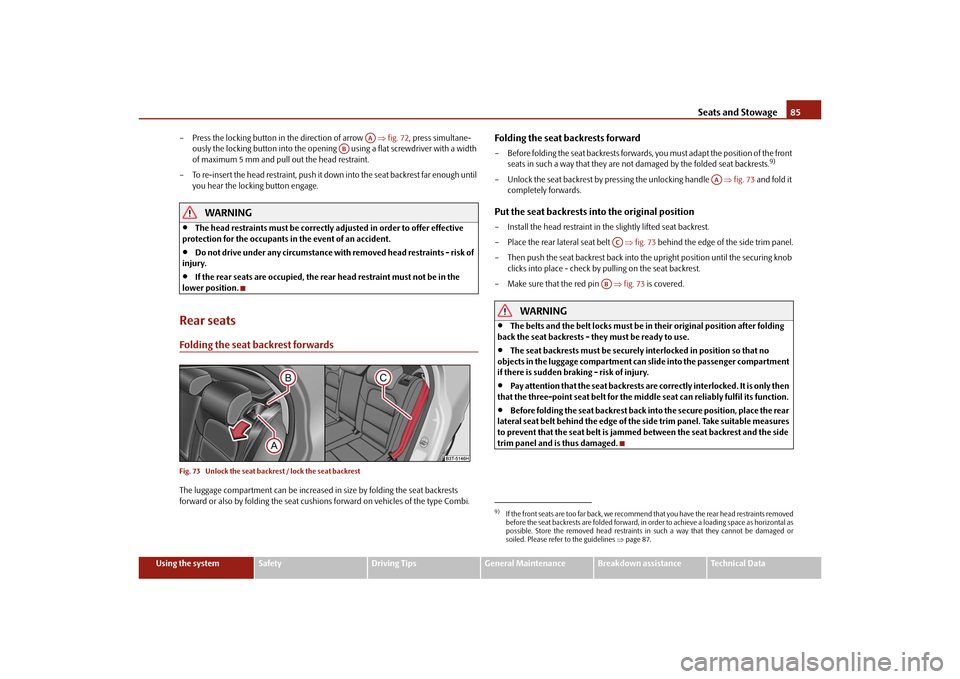
Seats and Stowage85
Using the system
Safety
Driving Tips
General Maintenance
Breakdown assistance
Technical Data
– Press the locking button in the direction of arrow
fig. 72 , press simultane-
ously the locking button into the opening using a flat screwdriver with a width
of maximum 5 mm and pull out the head restraint.
– To re-insert the head restraint, push it down into the seat backrest far enough until you hear the locking button engage.
WARNING
The head restraints must be correctly adjusted in order to offer effective
protection for the occupants in the event of an accident.
Do not drive under any circumstance with removed head restraints - risk of
injury.
If the rear seats are occupied, the rear head restraint must not be in the
lower position.
Rear seatsFolding the seat backrest forwardsFig. 73 Unlock the seat back rest / lock the seat backrestThe luggage compartment can be increased in size by folding the seat backrests
forward or also by folding the seat cushions forward on vehicles of the type Combi.
Folding the seat backrests forward– Before folding the seat backrests forwards, you must adapt the position of the front
seats in such a way that they are not damaged by the folded seat backrests.
9)
– Unlock the seat backrest by pressing the unlocking handle fig. 73 and fold it
completely forwards.Put the seat backrests into the original position– Install the head restraint in the slightly lifted seat backrest.
– Place the rear lateral seat belt fig. 73 behind the edge of the side trim panel.
– Then push the seat backrest back into th e upright position until the securing knob
clicks into place - check by pulling on the seat backrest.
– Make sure that the red pin fig. 73 is covered.
WARNING
The belts and the belt locks must be in their original position after folding
back the seat backrests - th ey must be ready to use.
The seat backrests must be securely interlocked in position so that no
objects in the luggage compartment can slide into the passenger compartment
if there is sudden braking - risk of injury.
Pay attention that the seat backrests are correctly interlocked. It is only then
that the three-point seat belt for the middle seat can reliably fulfil its function.
Before folding the seat backrest back into the secure position, place the rear
lateral seat belt behind the edge of the si de trim panel. Take suitable measures
to prevent that the seat belt is jammed between the seat backrest and the side
trim panel and is thus damaged.
AA
AB
9)If the front seats are too far back, we recommend that you have the rear head restraints removed
before the seat backrests are folded forward, in order to achieve a loading space as horizontal as
possible. Store the removed head restraints in such a way that they cannot be damaged or
soiled. Please refer to the guidelines page 87.
AA
AC
AB
s3fg.2.book Page 85 Friday, April 30, 2010 12:17 PM
Page 87 of 287
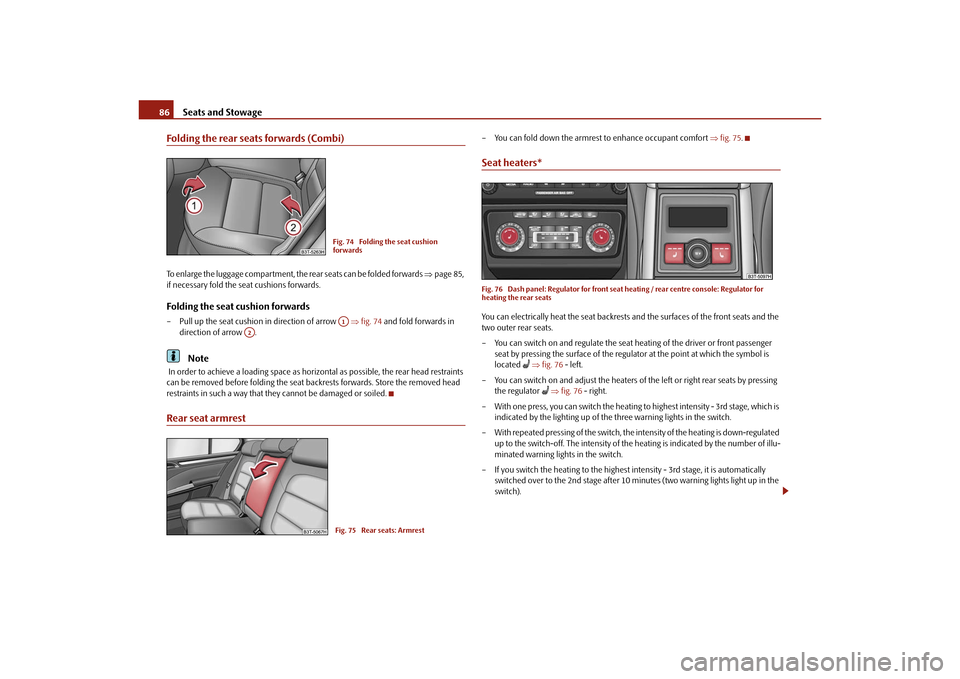
Seats and Stowage
86
Folding the rear seats forwards (Combi)To enlarge the luggage compartment, the rear seats can be folded forwards page 85,
if necessary fold the seat cushions forwards.Folding the seat cushion forwards– Pull up the seat cushion in direction of arrow fig. 74 and fold forwards in
direction of arrow .
Note
In order to achieve a loading space as horizo ntal as possible, the rear head restraints
can be removed before folding the seat backrests forwards. Store the removed head
restraints in such a way that th ey cannot be damaged or soiled.Rear seat armrest
– You can fold down the armrest to enhance occupant comfort fig. 75 .Seat heaters*Fig. 76 Dash panel: Regulator for front seat heating / rear centre console: Regulator for
heating the rear seatsYou can electrically heat the seat backrests and the surfaces of the front seats and the
two outer rear seats.
– You can switch on and regulate the seat heating of the driver or front passenger
seat by pressing the surface of the regulator at the point at which the symbol is
located
fig. 76 - left.
– You can switch on and adjust the heaters of the left or right rear seats by pressing the regulator
fig. 76 - right.
– With one press, you can switch the heating to highest intensity - 3rd stage, which is
indicated by the lighting up of the three warning lights in the switch.
– With repeated pressing of the switch, the intensity of the heating is down-regulated up to the switch-off. The intensity of the heating is indicated by the number of illu-
minated warning lights in the switch.
– If you switch the heating to the highest intensity - 3rd stage, it is automatically switched over to the 2nd stage after 10 mi nutes (two warning lights light up in the
switch).
Fig. 74 Folding the seat cushion
forwardsA1
A2
Fig. 75 Rear seats: Armrest
s3fg.2.book Page 86 Friday, April 30, 2010 12:17 PM
Page 88 of 287
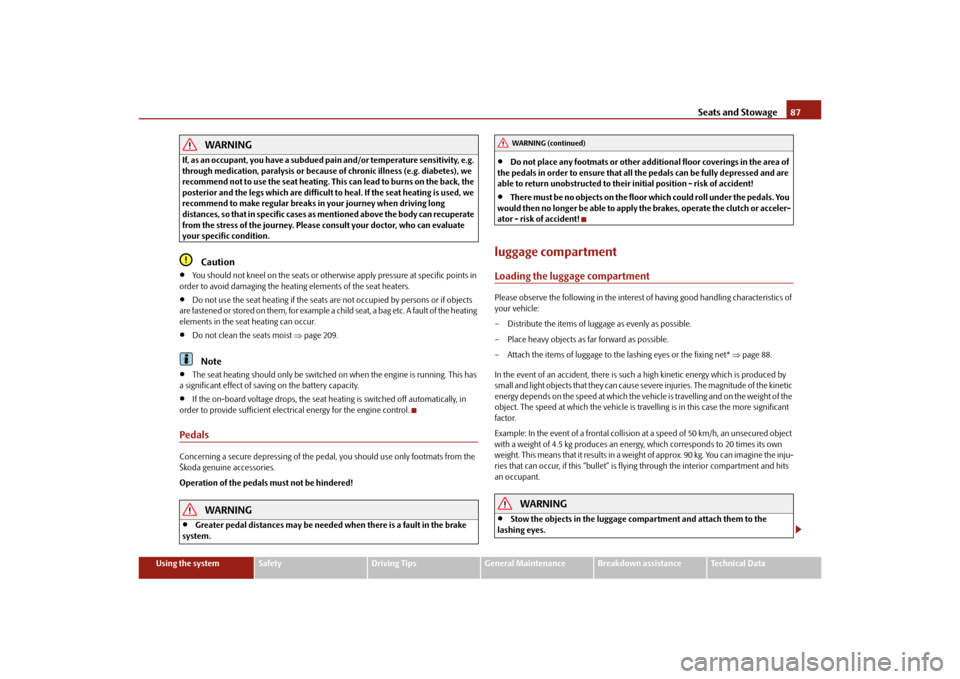
Seats and Stowage87
Using the system
Safety
Driving Tips
General Maintenance
Breakdown assistance
Technical Data
WARNING
If, as an occupant, you have a subdued pain and/or temp erature sensitivity, e.g.
through medication, paralysis or because of chronic illness (e.g. diabetes), we
recommend not to use the seat heating. Th is can lead to burns on the back, the
posterior and the legs which are difficult to heal. If the seat heating is used, we
recommend to make regular breaks in your journey when driving long
distances, so that in specific cases as mentioned above the body can recuperate
from the stress of the journey. Please consult your doctor, who can evaluate
your specific condition.
Caution
You should not kneel on the seats or otherwise apply pressure at specific points in
order to avoid damaging the heating elements of the seat heaters.
Do not use the seat heating if the seats are not occupied by persons or if objects
are fastened or stored on them, for example a child seat, a bag etc. A fault of the heating
elements in the seat heating can occur.
Do not clean the seats moist page 209.Note
The seat heating should only be switched on when the engine is running. This has
a significant effect of saving on the battery capacity.
If the on-board voltage drops, the seat heating is switched off automatically, in
order to provide sufficient electrical energy for the engine control.
PedalsConcerning a secure depressing of the peda l, you should use only footmats from the
Škoda genuine accessories.
Operation of the pedals must not be hindered!
WARNING
Greater pedal distances may be needed when there is a fault in the brake
system.
Do not place any footmats or other additional floor coverings in the area of
the pedals in order to ensure that all the pedals can be fully depressed and are
able to return unobstructed to their initial position - risk of accident!
There must be no objects on the floor which could roll under the pedals. You
would then no longer be able to apply the brakes, operate the clutch or acceler-
ator - risk of accident!
luggage compartmentLoading the luggage compartmentPlease observe the following in the interest of having good handling characteristics of
your vehicle:
– Distribute the items of luggage as evenly as possible.
– Place heavy objects as far forward as possible.
– Attach the items of luggage to the lashing eyes or the fixing net* page 88.
In the event of an accident, there is such a high kinetic energy which is produced by
small and light objects that they can cause severe injuries. The magnitude of the kinetic
energy depends on the speed at which the vehicle is travelling and on the weight of the
object. The speed at which the vehicle is trave lling is in this case the more significant
factor.
Example: In the event of a frontal collision at a speed of 50 km/h, an unsecured object
with a weight of 4.5 kg produces an en ergy, which corresponds to 20 times its own
weight. This means that it results in a weight of approx. 90 kg. You can imagine the inju-
ries that can occur, if this “bullet” is flying through the interior compartment and hits
an occupant.
WARNING
Stow the objects in the luggage compartment and attach them to the
lashing eyes.WARNING (continued)
s3fg.2.book Page 87 Friday, April 30, 2010 12:17 PM
Page 89 of 287

Seats and Stowage
88
Loose objects in the passenger compartment can be thrown forward during
a sudden manoeuvre or in case of an accident and can injure the occupants or
other oncoming traffic. This risk is still increased, if the objects which are flying
around are hit by a deployed airbag. In this case, the objects which are thrown
back can injure the occupants - hazard.
Please note that the handling properties of your vehicle may be affected
when transporting heavy objects as a result of the displacement of the centre of
gravity. The speed and style of driv ing must be adjusted accordingly.
The items carried in the luggage compar tment should be stowed in such a
way that no objects are able to slip fo rward if there are any sudden driving or
braking manoeuvres undertaken - risk of injury!
Never drive with the boot lid fully open ed or slightly ajar otherwise exhaust
gases may get into the interior of the vehicle - risk of poisoning!
On no account exceed the permissible axle loads and the permissible gross
weight of the vehicle - risk of accident!
Never transport occupants in the luggage compartment!Caution
Make sure that transported objects with sharp edges do not damage the following:
heating elements in the rear window,
elements of the aerial integrated in the rear window (Superb),
elements of the aerial integrated in the rear side windows (Combi).Note
Tyre pressure must be adjusted to the load page 228, fig. 189.Vehicles of category N1On vehicles of the category N1, which are not fitted with a protective grille, a lashing
set which complies with the standard EN 12195 (1 - 4) must be used for fastening the
load.
Lashing eyesEyes are located on the sides of the luggage compartment for lashing the goods to be
loaded.
You can also attach a floor fixing net* to these eyes for holding small objects.
WARNING
The load to be transported must be fixed in place in such a way that it cannot
move during the journey and when braking.
If the items of luggage or objects are attached to the lashing eyes with
unsuitable or damaged lashing straps, inju ries can occur in the event of braking
manoeuvres or accidents. In order to prevent the items of luggage being thrown
forward, always use suitable lashing st raps which are firmly attached to the
lashing eyes.
WARNING (continued)
Fig. 77 Luggage compartment: Lashing
eyes
s3fg.2.book Page 88 Friday, April 30, 2010 12:17 PM
Page 91 of 287

Seats and Stowage
90
Fixing floor covering of the luggage compartmentFig. 81 Luggage compartment: Fixing of the fl oor covering / luggage compartment: Fixing of
the floor covering (Combi)A loop fig. 81 left is located on the floor covering of the luggage compartment and
a hook fig. 81 right is located on the underside of the floor covering. When handling
the spare wheel*, you can raise the floor covering and fix it on a hook at the luggage
compartment cover.Luggage net*The luggage net is designed for the tranportation of lighter objects.
WARNING
In the storage net you must only stow objects (up to a total weight of 1.5 kg).
Heavy objects are not secured sufficiently - risk of injury!
No objects with sharp edges should be stowed in the luggage net, because
they can damage the luggage net.
Luggage compartment cover
You can use the luggage compartment cover behind the head
restraints for storing light and soft items.The luggage compartment cover can be remo ved as required if one must transport
bulky goods.
– Unhook the support straps fig. 83.
– Place the cover in th e horizontal position.
– Pull the cover out of the holder horizontally to the rear.
– Install again by pushing the luggage compartment cover forwards into the holder and hanging the support straps on the boot lid.
You can stow the removed luggage compartmen t cover behind the rear seat backrest.
WARNING
No objects should be placed on the luggage compartment cover, the vehicle
occupants could be endangered if th ere is sudden braking or the vehicle
collides with something.
Fig. 82 Luggage compartment: Luggage
net
WARNING (continued)
Fig. 83 Removing the luggage compart-
ment cover
A1
A2
A2
A1
s3fg.2.book Page 90 Friday, April 30, 2010 12:17 PM
Page 94 of 287

Seats and Stowage93
Using the system
Safety
Driving Tips
General Maintenance
Breakdown assistance
Technical Data
Partially pulling out the variable loading floor*Fig. 87 Luggage compartment: partially pulling out the variable loading floorThe variable loading floor can be partially pulled out over the rear bumper. The vari-
able loading floor which is pulled out in such a way is solely used as a seat, for example
for changing shoes. When pulling out the va riable loading floor, the front edge (close
to the rear seats) is lifted at the same ti me. Thus, small objects can no longer fall into
the space between the luggage compartmen t floor and the variable loading floor.
– Grasp the rear par t of the variable floor at the handle, raise it slightly in direction of arrow fig. 87 and pull it over the bumper in direction of arrow until it
engages in the opening fig. 87 .
– Grasp the part of the floor at the handle, raise it slightly in direction of arrow and push it forwards up to the stop in order to push in the variable loading floor.
Caution
Ensure that the raised front edge of the variable loading floor is not damaged.
Dividing the luggage compartment with variable loading floor*The luggage compartment can be divided with the variable loading floor.
– Grasp the rear part of the floor at the handle, raise it in direction of arrow
page 93, fig. 87 and insert the rear edge in one of the openings fig. 88 .
The variable loading floor is secured in the openings against movement.
The variable loading floor can be pulled out some more before dividing the luggage
compartment with the variable loading floor page 93. This enlarges the space
between the rear seats and the separation.
Caution
Ensure that the raised front edge of the variable loading floor is not damaged.
A1
A2
AC
A1
Fig. 88 Divide the luggage compartment
A1
AA
AA
s3fg.2.book Page 93 Friday, April 30, 2010 12:17 PM
Page 95 of 287
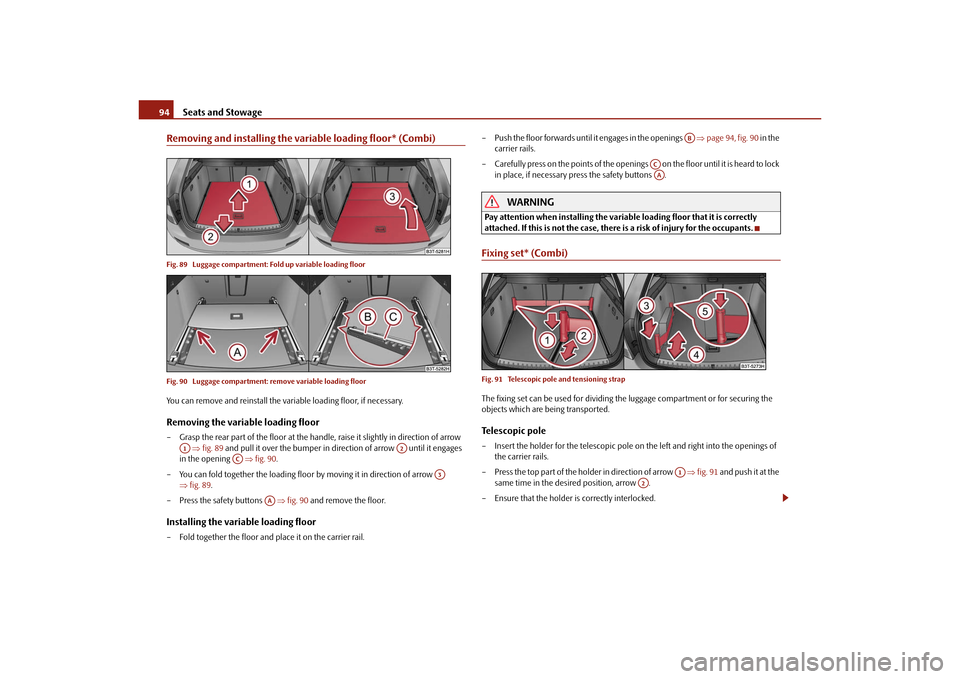
Seats and Stowage
94
Removing and installing the var iable loading floor* (Combi)Fig. 89 Luggage compartment: Fold up variable loading floor
Fig. 90 Luggage compartment: remove variable loading floorYou can remove and reinstall the variable loading floor, if necessary.Removing the variable loading floor– Grasp the rear part of the floor at the handle, raise it slightly in direction of arrow
fig. 89 and pull it over the bumper in direction of arrow until it engages
in the opening fig. 90 .
– You can fold together the loading floor by moving it in direction of arrow
fig. 89 .
– Press the safety buttons fig. 90 and remove the floor.Installing the variable loading floor– Fold together the floor and place it on the carrier rail. – Push the floor forwards until it engages in the openings
page 94, fig. 90 in the
carrier rails.
– Carefully press on the points of the openings on the f loor unti l it i s hea rd to l ock
in place, if necessary press the safety buttons .
WARNING
Pay attention when installing the variable loading floor that it is correctly
attached. If this is not the case, there is a risk of injury for the occupants.Fixing set* (Combi)Fig. 91 Telescopic pole and tensioning strapThe fixing set can be used for dividing the luggage comp artment or for securing the
objects which are being transported.Telescopic pole– Insert the holder for the telescopic pole on the left and right into the openings of the carrier rails.
– Press the top part of the holder in direction of arrow fig. 91 and push it at the
same time in the desired position, arrow .
– Ensure that the holder is correctly interlocked.
A1
A2
AC
A3
AA
AB
ACAA
A1
A2
s3fg.2.book Page 94 Friday, April 30, 2010 12:17 PM
Page 96 of 287

Seats and Stowage95
Using the system
Safety
Driving Tips
General Maintenance
Breakdown assistance
Technical Data
Tensioning strap– Insert the holder of the tensioning strap in to the opening of the left or right carrier
rail.
– Press the holder in direction of arrow fig. 91 and push it at the same time in
the desired position, arrow .
– Ensure that the holder is correctly interlocked.
– Place the object which should be fa stened behind the tensioning strap.
– Press the button on the top side of the holder and tighten the strap.
WARNING
The objects in the luggage compartment must be firmly secured with the fixing
set so that they cannot move freely and uncontrollably in order to prevent
damage to objects or injuries to the occupants.
Note
Do not use the fixing set fo r securing objects which mi ght damage the fixing set.
The tensioning strap can also be fully reeled up by pressing the button
fig. 91 .
Moveable lashing eyes* (Combi)Fig. 92 Moveable lashing eyes
Four moveable lashing eyes, which can be used for example for attaching the fixing
net, are located in the luggage compartment.
– Press the button page 95, fig. 92 and push the lashing eye in the desired
position, arrow .
– Fold up the clamp page 95, fig. 92 and fix, for example, the fixing net.Net partition* (Combi)Use the net partition behind the rear seatsPulling out– Pull the net partition at the bracket fig. 93 out of the housing in direction
of the holders .
– Insert the cross rod into one of the mounts and push the cross rod forwards.
– In the same way, fix the cross rod to the other side of the vehicle, mount .Folding– Pull the cross rod back slightly, first on the one side then on the other side and take the cross rod out of the mounts fig. 93 .
– Hold the cross rod in such a way that the net partition can roll up into the housing
slowly and without damage.
A3
A4
A5
A5
A1A2A3
Fig. 93 Pull out the net partition
AA
AB
AC
AC
AC
AC
AB
s3fg.2.book Page 95 Friday, April 30, 2010 12:17 PM
Page 97 of 287
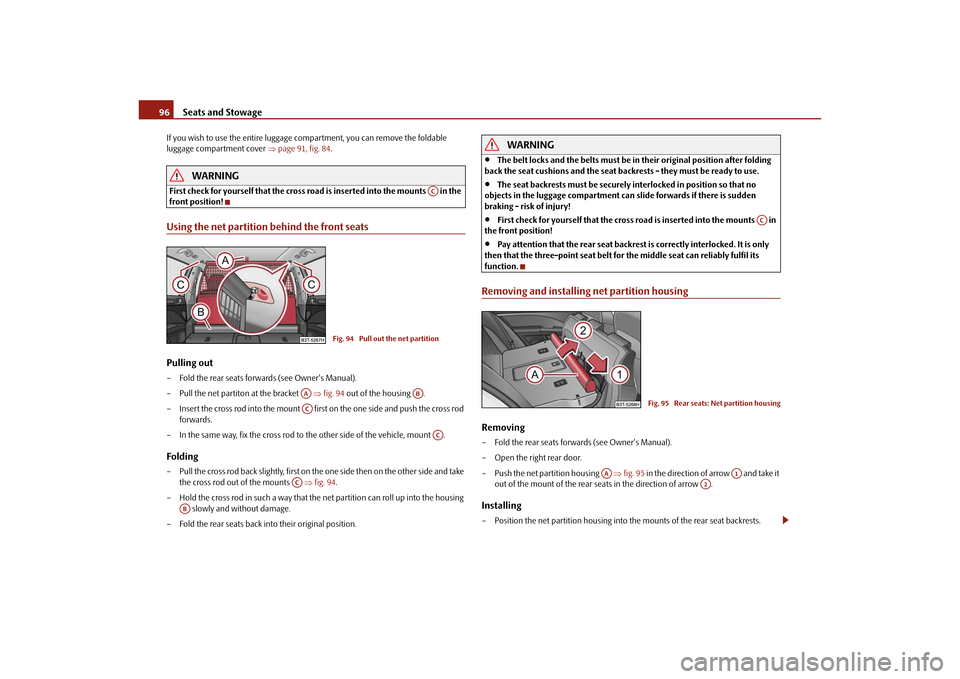
Seats and Stowage
96
If you wish to use the entire luggage co mpartment, you can remove the foldable
luggage compartment cover page 91, fig. 84 .
WARNING
First check for yourself that the cross road is inserted into the mounts in the
front position!Using the net partition behind the front seatsPulling out– Fold the rear seats forwards (see Owner's Manual).
– Pull the net partiton at the bracket fig. 94 out of the housing .
– Insert the cross rod into the mount first on the one side and push the cross rod forwards.
– In the same way, fix the cross rod to the other side of the vehicle, mount .Folding– Pull the cross rod back slightly, first on th e one side then on the other side and take
the cross rod out of the mounts fig. 94 .
– Hold the cross rod in such a way that the net partition can roll up into the housing
slowly and without damage.
– Fold the rear seats back into their original position.
WARNING
The belt locks and the belts must be in their original position after folding
back the seat cushions and the seat backrests - they must be ready to use.
The seat backrests must be securely interlocked in position so that no
objects in the luggage compartment can slide forwards if there is sudden
braking - risk of injury!
First check for yourself that the cross road is inserted into the mounts in
the front position!
Pay attention that the rear seat backrest is correctly interlocked. It is only
then that the three-point seat belt for the middle seat can reliably fulfil its
function.
Removing and installing net partition housingRemoving– Fold the rear seats forwards (see Owner's Manual).
– Open the right rear door.
– Push the net partition housing fig. 95 in the direction of arrow and take it
out of the mount of the rear seats in the direction of arrow .Installing– Position the net partition housing into the mounts of the rear seat backrests.
AC
Fig. 94 Pull out the net partition
AA
AB
AC
AC
AC
AB
AC
Fig. 95 Rear seats: Net partition housing
AA
A1
A2
s3fg.2.book Page 96 Friday, April 30, 2010 12:17 PM
Page 101 of 287

Seats and Stowage
100
Cigarette lighter*, power socketsCigarette lighter
You can also use the socket on the ci garette lighter for other electrical
appliances.Using the cigarette lighter– Press the button of the lighter fig. 101 or page 99, fig. 100.
– Wait until the button jumps forward.
– Remove the cigarette lighter immediately and use it.
– Insert the cigarette lighter again into the socket.Using the socket– Remove the cigarette lighter or the cover of the power socket.
– Connect the plug of the electrical appliance to the socket.
The 12 volt power socket can also be used to supply power to additional electrical
accessories with a power uptake up to 120 watts.
WARNING
Take care when using the cigarette ligh ter! Not paying proper attention or
incorrect use the cigarette lighter in an uncontrolled manner may result in
burns.
The cigarette lighter and the power socket also operates when the ignition is
switched off or the ignition key withdrawn. You should therefore never leave
children unattended in the vehicle.Caution
Always use matching plugs to avoid damagi ng the power socket.
Note
Connecting electrical components when the engine is not running will drain
the battery of the vehicle - risk of battery draining!
Further information page 234.
Power socket in the luggage compartmentFig. 102 Luggage compartment: Power socket / luggage compartment: Power socket (Combi)– Open the cover of the power socket fig. 102 .
– Connect the plug of the electrical appliance to the socket.
You can only use the power socket for the co nnection of approved electrical accesso-
ries with a power uptake up to 120 watts. The vehicle battery will be discharged in the
process if the engine is stationary.
The same remarks apply here as for page 100.
Further information page 234.Storage compartmentsOverviewYou will find the following storag e facilities in your vehicle:
AA
AB
s3fg.2.book Page 100 Friday, April 30, 2010 12:17 PM